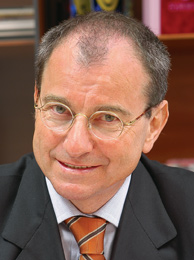Europe's online source of news, data & analysis for professionals involved in packaged media and new delivery technologies
Packaging with Italian flair

“I dress CDs and DVDs the way Armani dresses women,” says ALDO POZZOLI, founder and CEO of the company that bears his name and which celebrates its 40th anniversary. He tells JEAN-LUC RENAUD, DVD Intelligence publisher, the secrets of his success.
The company you founded celebrates its 40th anniversary. How did it all start?
Pozzoli: We started with the music business. Independent Italian music labels were very big in the 60s and 70s. Not only independent labels, but also local subsidiaries of international labels like Warner were independent in terms of manufacturing. They had their own pressing plants in Italy. Records of international artists like Bob Dylan, Bob Marley, the Beatles were produced through local manufacturers.
We worked a lot with these independent labels and artists. They were looking for innovative jackets for their LPs, not just plain cardboard sleeves. For the big names, special packaging was especially important. So, I established the company in 1968, producing vinyl jackets for LPs. This was our main business from 1968 to 1984 when vinyl was the only media. During those years, we did not need to sell our products abroad because Italy was a big market for music.
From the outset, you positioned Pozzoli as a provider of specialty products.
Then the market change radically when the majors centralized their operations. International releases, artwork and design were now decided in London or in the USA, not anymore in Italy. So, we no longer had a direct stake. We could only execute what was decided elsewhere. We could still be involved in the creative side of packaging for local Italian artists, though.
When the CD came about, we were initially worried because of the smaller space available for artwork on a CD case. The packaging had to change. Whereas up to now, only three or four companies were able to do the very specialised vinyl sleeves we were making, a very large number of companies could supply the artwork for CD cases as the graphics requirements were minimal, sometimes only a single inside sheet was sufficient in a jewel box.
We needed to take a drastic new direction to compete with the 20,000 printers in Italy that could supply CD inlay cards. We decided to install the first CD replication line in Italy. So, Pozzoli could become a one-stop shop and supply the jewel case with graphics and CD. At the time, no-one in the country could offer this capability under one roof.
From 1986 to 1992, we supplied local independents and major labels with finished products – CD, jewel case and inlays. In the early 90s, everything changed again as the major music companies decided to centralize their production and build their own manufacturing sites. EMI set up plant in Uden, Universal (Polygram at the time) in Langenhagen, Warner in Alsdorf, BMG in Gütersloh. They all closed their local production sites. So we lost our local production contracts as Italian titles were now manufactured in those centralized sites.
A new strategy was called for as the business was going elsewhere. My son Luigi went abroad, to London, to re-establish direct contact with the major labels’ headquarters. We managed to convince them of Pozzoli’s creativity and quality and of the important role of a quality packaging for their releases.
The packaging for DVD was very creative from the start of that format. To what extent this influenced packaging solutions for CDs?
No, our ideas for CD packaging were already there. Special packaging has always been part of the music business, with vinyl or CDs. We were even proposing creative solutions for minicassettes. In our company, we do not think the arrival of DVD led to a surge in CD packaging creativity.
Did you have to convince distributors and retailers to accept new packaging that might take more shelve space?
You are talking 2008 terminology! In the 1980s, ‘shelf space’ was not a word that existed. When the big size LPs disappeared, retailers gained so much space they were happy to fill it.
No, we never talked to retailers or distributors. But, in all our concept ideas there is always the thought of what the end user will think. So, our solutions need to be creative, practical, resistant, easy to stock from the point of view of our clients. We always thought the end users will be happy to buy products in special packaging, rather than a simple insert in plastic. The secret of the company’s longevity is to keep in mind the satisfaction of the end-users.
Because I so strongly believe in that approach, I often have to fight with the labels and their HQs, going against prevailing ideas. Like many of our competitors, they like calm waters, I prefer the stormy sea. When you are used to sailing in stormy weather, you are not afraid of taking risks.
Where does your interest in creative design come from?
Modestly I try to do similar to what Armani and Valentino do. They have created wonderful dresses and suits for women and men while I’ve created beautiful dresses for CD and DVD. I like to be always a step ahead. Thanks to our R&D team, we have developed a number of patents that are used internationally, like the twin tray, licensed worldwide.
How did you bring this creativity for CDs to DVDs?
In some respect, it was easier. With music you have a few genres – classical, pop, jazz, etc. With DVDs you can apply creativity on each individual movie title. Packaging for them lends itself to a broader spectrum of design solutions.
With the music business going online, the need for CD cases diminishes. This must impact your bottom line?
Though the music business is going down 5%,10%,15% each year, our activities in music are increasing. The reason is that to sell the ever-reducing volume of music they handle, the labels have to use creative packaging. Also, to sell on a physical media something which is already available online, publishers need to add value through creative packaging.
What is your international presence?
Some 65% of our revenues are generated outside Italy. We have opened offices in London, Frankfurt and Paris and we have just announced a partnership with Multi Packaging Solutions, a leading US company in the media packaging sector. We think the US market could do with our creativity. Through affiliates, we are present in the Asia Pacific markets – Australia, Japan.
What is your strategy on eco-friendly, green products? Do you see all your products at some point becoming green?
We are moving all the processes, all the company activities, in this direction. We have developed a new line of green packaging together with a packing machine. If the market chooses ecological packaging, we are in the best position to service.
Actually, we push our clients to go ecological with new packaging solutions. Customers want eco packaging but do not want to spend more than what they earmark for standard packaging. They even want to pay less. At the end of the day, everyone – manufacturers and customers, majors and independent labels – must do its part to save the world. Everyone must make a little sacrifice. We cannot be the only one making sacrifice.
Going green must cost more. Do you sense that customers are willing to pay a little bit more?
With the introduction of green products it’s not much different. Let’s get real. The cost differential between a normal packaging and a green one is not that big.
On a volume of 10,000 units, the difference can be of a few cents. In the overall price of the packaged disc, this price increase cannot be the reason for not going green. We have noted that queries for green quotations have increased sharply. People are getting more and more aware of green issues.
The packaging for Blu-ray and HD DVD came under criticism for looking cheap? The hi-def format has just entered the market and you are already offering new, more attractive solutions. Are studios interested to diversify BD packaging at this early stage?
We will see. BD is still at a very early stage of market development but many companies are already trying to offer various solutions. We have exciting solutions of our own to offer. That’s why we are keen to establish this link-up with the US through our local partner. We cannot do it from Italy, we cannot influence from here. We have to go to the Hollywood studios and develop new packaging with them.
How are you planning the end of physical media?
We believe there will always be a need for our type of packaging for niche markets. Because the world is big, niche markets can be very big.
Another reason for the joint venture with our US partner, beside breaking into the US market, is to bring our knowledge and creativity to other market sectors like cosmetics, videogames, pharmaceutical into which our US partner is well introduced.
Critically, you have to make changes when the company is healthy. Never make a change when you are dying. Should we implement these changes in 3 years time, it would be too late. It’s for this reason that we look at the future and go to the United States in time.
How do you see the company in five years time?
Our growth can only be organic. Our in-house culture and vision make it difficult to consider expansion through acquisition. Many companies that were thriving 10 years ago, have disappeared. This is the business we are in. Our future rests on diversification where we can apply our creative thinking. I am very proud to have created and still own a company with an international reputation that is an Italian company....
On predicting the future

Predicting the future, let alone the future of packaged media, is a perilous exercise, and possibly counter-productive, as the exercise closes doors rather than keep them open, argues JEAN-LUC RENAUD, DVD Intelligence publisher. Consider that: Apple was left nearly for dead 15 years ago. Today, it became the world's most valuable technology company, topping Microsoft.
Le cinéma est une invention sans avenir (the cinema is an invention without any future) famously claimed the Lumière Brothers some 120 years ago. Well. The cinématographe grew into a big business, even bigger in times of economic crisis when people have little money to spend on any other business.
The advent of radio, then television, was to kill the cinema. With a plethora of digital TV channels, a huge DVD market, a wealth of online delivery options, a massive counterfeit underworld and illegal downloading on a large scale, cinema box office last year broke records!
The telephone was said to have no future when it came about. Today, 5 billion handsets are in use worldwide. People prioritize mobile phones over drinking water in many Third World countries.
No-one predicted the arrival of the iPod only one year before it broke loose in an unsuspecting market. Even fewer predicted it was going to revolutionise the economics of music distribution. Likewise, no-one saw the iPhone coming and even fewer forecast the birth of the developers' industry it ignited. And it changed the concept of mobile phone.
Make no mistake, the iPad will have a profound impact on the publishing world. It will bring new players, and smaller, perhaps more creative content creators.
And who predicted the revival of vinyl?
(click to continue)... Read More...



















